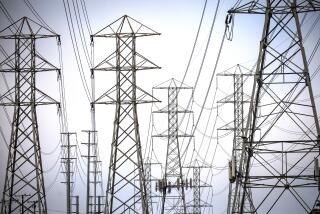Setting, Clean Coils Can Cool Off Refrigerator Bills
- Share via
QUESTION: I recently read in an article that refrigerators use enormous amounts of electricity. What can I do to make the operation of my refrigerator more efficient?
ANSWER: Refrigerators are the third largest consumer of energy in the home. Space heating and water heating are the first and second largest users. The thermostat setting can make a big difference in how much electricity a refrigerator uses. Most settings don’t tell you the real temperature.
To determine what setting to use, keep a thermometer in the refrigerator compartment to check the accuracy of the thermostat and adjust the setting between 37 and 40 degrees Fahrenheit.
If the freezer compartment has a separate thermostat, set it between 0 and 5 degrees. Stand-alone freezers should be set at 0 degrees. You can pick up a refrigerator thermometer at most grocery stores for less than $3.
When checking the temperature inside your refrigerator, take it in several places. Varying temperatures may mean you need to defrost the freezer compartment or vacuum the condenser coils below or at the back of the refrigerator.
Dusty coils make the unit use more electricity and cause your refrigerator to malfunction. Clean the coils at least once a year. Remember to unplug the refrigerator before cleaning the coils.
Here are some more ways to keep things cool more efficiently:
Check the refrigerator door for cracked and leaky door seals. Replace them if they do not seal properly.
Do not overfill food in either refrigerator or freezer so you allow room for the air to circulate freely around foods.
Cool hot foods before you store them by letting them sit for a while. This way your refrigerator doesn’t have to work so hard.
For good air circulation, allow at least a one inch space on each side of the refrigerator.
Locate refrigerators away from heat sources (ovens and dishwashers) and away from direct sunlight.
Defrost the freezer compartment (on manual defrost refrigerators) when ice build-up is one-fourth inch thick.
Remember to unplug the old refrigerator in your garage or basement. Old refrigerators can use twice as much electricity as new models of the same size.
Getting to the Root of Sewer-Line Problem
Q: I live in a one-bath, 50-year-old house that has a sewer line that regularly backs up. About every eight to 10 months, I have to hire someone to clear it. I think the cause of my troubles is some juniper trees and an English box hedge planted on one side. What do you suggest is the best or most economical long-term solution?
A: We recommend contacting one of the sewer and drain cleaning companies found in the Yellow Pages of the telephone book under sewer cleaning. Many of these companies now have video cameras which can be inserted into sewer lines to scope out problems. This is expensive, but much less than digging out the whole sewer line.
Once the problem has been defined, there are several solutions:
If the problem is roots, then a regular maintenance schedule to cut the roots can be set up. This is the way the city handles many of its sewer lines that are being invaded by roots. This is preferable to removing valuable trees.
The sewer line could be dug up at the obstruction points, and repairs made there. However--if the problem is root invasion they will simply move to the next pipe joint and eventually invade at a new point.
Any attempt to use strong chemicals will not only be very dangerous to the environment, but will also result in roots moving to new locations.
We recommend avoiding strong chemicals to remedy the root problem since it’s only a temporary solution and harmful to the environment.
Carpeting and Pads Have Insulating Factor
Q: How much insulation value am I receiving from my carpet pad?
A: Insulation values (R values) for carpets and pad will vary depending on the material used. An average carpet will have an R-value of about 2 to 2.4 per inch. Pads will vary from about R-1.5 inch for 48-ounce waffled sponge rubber to 4 to 4.18 inches for 4-pound bounded urethane.
The total thickness and density of a carpet and pad have been found to be more important to energy conservation than the type of fiber used. Tests have shown that combinations of carpet and pads can cut down on the heat loss through the floor as much as 73% when installed on an uninsulated concrete slab and 54% on an uninsulated wood floor over a conventional ventilated crawl space.
However, if the floor is already insulated, savings will be less. For floors insulated to R-19, the saving is about 5%, while R-11 would bring roughly a 9% saving.
More to Read
Eat your way across L.A.
Get our weekly Tasting Notes newsletter for reviews, news and more.
You may occasionally receive promotional content from the Los Angeles Times.









